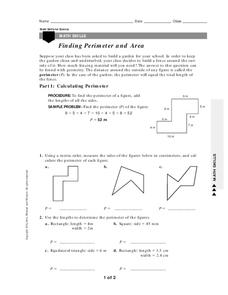Curated OER
Laboratory: Modeling Molecular Shapes
In this molecules worksheet, students answer post lab questions about types of bonds, factors that determine polarity and molecular geometry. They calculate electronegativity differences in atoms and determine the types of bonds between...
Curated OER
Lewis Structure Worksheet
In this chemistry worksheet, students draw the Lewis structures of 9 compounds and polyatomic ions, identify their molecular shapes and polarity.
Curated OER
Polygons and Vertices
In this geometry worksheet, students analyze different polygons and relate it to a circuit board. They find the odd degree Euler circuit and identify the vertices of the odd degree. There are 3 questions with an answer key.
Curated OER
VSEPR And Polarity
In this VSEPR theory learning exercise, students evaluate the electron-pair geometry of organic and inorganic molecules. They construct Lewis structures and resonance structures for 17 compounds and complete 3 short answer questions.
Curated OER
Finding Perimeter and Area
In this area and perimeter worksheet, students are given the equations to find the perimeter and area of objects. They practice finding the perimeter by measuring the sides of given objects and adding them together. They find the area of...
Curated OER
Lewis Structures and Bonding
For this compounds worksheet, students complete a graphic organizer by filling in the chemical compounds structure, resonance, geometry, hybridization, and bond angles. Then students complete 2 short answer questions.
Curated OER
Organic Chemistry 231, Martin Larter, Exam 1
If you need a straightforward and comprehensive organic chemistry exam, check this one out. Chemistry pupils identify functional groups in molecule diagrams, draw a Lewis structure, fill in a table about molecular shape, predict boiling...
National Institute of Open Schooling
Chemical Bonding
Name is Bond, covalent bond. Through readings and answering questions, classes explore the different types of chemical bonds, their characteristics, valence shell electron pair repulsion theory, and atomic orbitals.
Curated OER
Teaching About Plate Tectonics and Faulting Using Foam Models
Young scientists learn about plate tectonics and the three different types of faults (normal, reverse, and strike-slip) using foam models. The activity also covers common types of locations where these faults are found.








